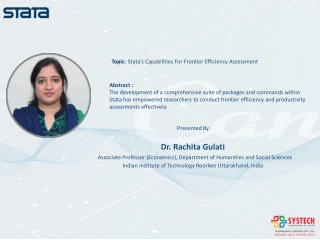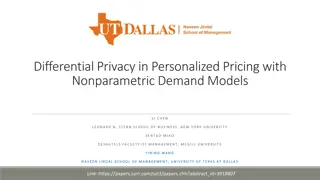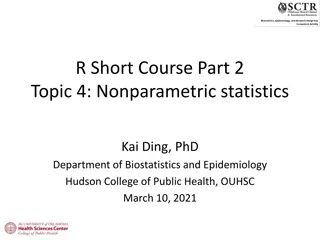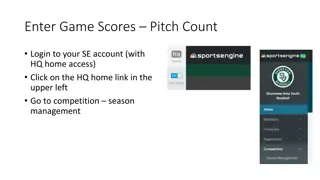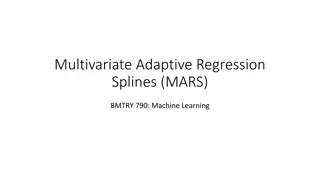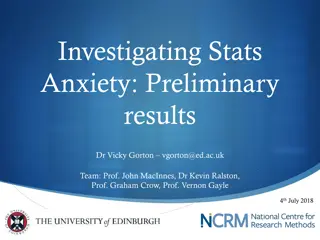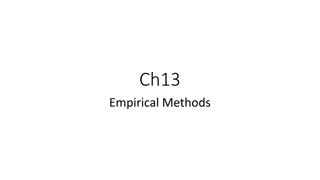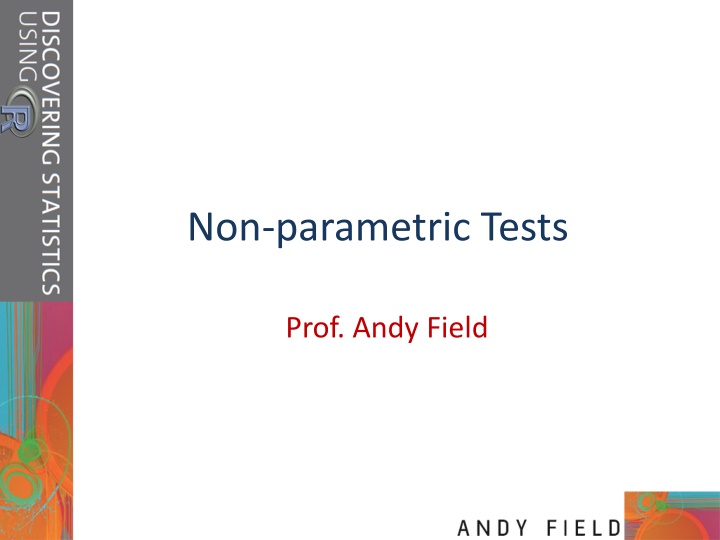
Understanding Nonparametric Tests: When and How to Use Them
Learn about nonparametric tests and when to use them in statistical analysis when parametric test assumptions are not met. Explore tests like Wilcoxon rank-sum test, Kruskal-Wallis test, and how to interpret and report results effectively.
Download Presentation

Please find below an Image/Link to download the presentation.
The content on the website is provided AS IS for your information and personal use only. It may not be sold, licensed, or shared on other websites without obtaining consent from the author. If you encounter any issues during the download, it is possible that the publisher has removed the file from their server.
You are allowed to download the files provided on this website for personal or commercial use, subject to the condition that they are used lawfully. All files are the property of their respective owners.
The content on the website is provided AS IS for your information and personal use only. It may not be sold, licensed, or shared on other websites without obtaining consent from the author.
E N D
Presentation Transcript
Non-parametric Tests Prof. Andy Field
Aims When and why do we use non-parametric tests? Wilcoxon rank-sum test Wilcoxon signed-rank test Kruskal Wallis test Jonckheere Terpstra test Friedman s ANOVA Ranking data Interpretation of results Reporting results Calculating an effect size
When to Use Nonparametric Tests Non-parametric tests are used when assumptions of parametric tests are not met. It is not always possible to correct for problems with the distribution of a data set In these cases we have to use non-parametric tests. They make fewer assumptions about the type of data on which they can be used.
The Wilcoxon rank-sum test The non-parametric equivalent of the independent t-test. Use to test differences between two conditions in which different participants have been used.
Ranking Data The test works on the principle of ranking the data for each group: Lowest score = a rank of 1, Next highest score = a rank of 2, and so on. Tied ranks are given the same rank: the average of the potential ranks. For an unequal group size The test statistic (Ws) = sum of ranks in the group that contains the least people. For an equal group size Ws = the value of the smaller summed rank. Add up the ranks for the two groups and take the lowest of these sums to be our test statistic. The analysis is carried out on the ranks rather than the actual data.
An Example A neurologist investigated the depressant effects of certain recreational drugs. Tested 20 clubbers. 10 were given an ecstasy tablet to take on a Saturday night. 10 were allowed to drink only alcohol. Levels of depression were measured using the Beck Depression Inventory (BDI) the day after and midweek. Rank the data ignoring the group to which a person belonged. A similar number of high and low ranks in each group suggests depression levels do not differ between the groups. A greater number of high ranks in the ecstasy group than the alcohol group suggests the ecstasy group is more depressed than the alcohol group.
Ranking the Depression Scores for Wednesday and Sunday
Running the Analysis Using R Commander The Nonparametric Tests menu in R Commander and the dialog box for the Wilcoxon test for independent samples
Running the Analysis Using R If you have the data for different groups stored in a single column: newModel<-wilcox.test(outcome ~ predictor, data = dataFrame, paired = FALSE/TRUE) However, if you have the data for different groups stored in two columns: newModel<-wilcox.test(scores group 1, scores group 2, paired = FALSE/TRUE)
Running the Analysis Using R To compute a basic Wilcoxon test for our Sunday data we could execute: sunModel<-wilcox.test(sundayBDI ~ drug, data = drugData) sunModel For the Wednesday data: wedModel<-wilcox.test(wedsBDI ~ drug, data = drugData) wedModel
Output from the Wilcoxon Rank- Sum Test
Reporting the Results Depression levels in ecstasy users (Mdn = 17.50) did not differ significantly from alcohol users (Mdn = 16.00) the day after the drugs were taken, W= 35.5, p = .286. However, by Wednesday, ecstasy users (Mdn = 33.50) were significantly more depressed than alcohol users (Mdn = 7.50), W = 4, p < .001.
Comparing Two Related Conditions: the Wilcoxon Signed-Rank Test Uses: To compare two sets of scores, when these scores come from the same participants. Imagine the experimenter in the previous example was interested in the change in depression levels for each of the two drugs. We still have to use a non-parametric test because the distributions of scores for both drugs were non-normal on one of the two days.
Ranking Data in the Wilcoxon signed-rank test
Running the Analysis Using R Commander R Commander menu and dialog box for subset
Running the Analysis Using R Commander Dialog box for the Wilcoxon signed-rank test
Running the Analysis Using R We want to run our analysis on the alcohol and ecstasy groups separately; therefore, our first job is to split the dataframe into two using the subset() function: alcoholData<-subset(drugData, drug == "Alcohol") ecstasyData<-subset(drugData, drug == "Ecstacy")
Running the Analysis Using R To run the analysis for the alcohol group execute: alcoholModel<-wilcox.test(alcoholData$wedsBDI, alcoholData$sundayBDI, paired = TRUE, correct= FALSE) alcoholModel and for the ecstasy group: ecstasyModel<-wilcox.test(ecstasyData$wedsBDI, ecstasyData$sundayBDI, paired = TRUE, correct= FALSE) ecstasyModel
Reporting the results For ecstasy users, depression levels were significantly higher on Wednesday (Mdn = 33.50) than on Sunday (Mdn = 17.50), p = .047. However, for alcohol users the opposite was true: depression levels were significantly lower on Wednesday (Mdn = 7.50) than on Sunday (Mdn = 16.0), p = .012.
Differences between Several Independent Groups: the Kruskal Wallis test The Kruskal Wallis test (Kruskal & Wallis, 1952) is the non-parametric counterpart of the one-way independent ANOVA. If you have data that have violated an assumption then this test can be a useful way around the problem. The theory for the Kruskal Wallis test is very similar to that of the Wilcoxon rank-sum test: The Kruskal Wallis test is based on ranked data. The sum of ranks for each group is denoted by Ri (where i is used to denote the particular group).
KruskalWallis Theory Once the sum of ranks has been calculated for each group, the test statistic, H, is calculated as: Riis the sum of ranks for each group N is the total sample size (in this case 80) niis the sample size of a particular group (in this case we have equal sample sizes and they are all 20).
Example Does eating soya affect your sperm count? Variables Outcome: sperm (millions) IV: Number of soya meals per week No Soya meals 1 Soya meal 4 soya meals 7 soya meals Participants 80 males (20 in each group)
Provisional Analysis Run some exploratory analyses on the data.
Doing the KruskalWallis Test Using R Commander
Doing the KruskalWallis Test Using R For the current data: kruskal.test(Sperm ~ Soya, data = soyaData) To interpret the Kruskal Wallis test, it is useful to obtain the mean rank for each group: soyaData$Ranks<-rank(soyaData$Sperm) This command creates a variable Ranks in soyaData dataframe that is the ranks for the variable Sperm. We can then obtain the mean rank for each group: by(soyaData$Ranks, soyaData$Soya, mean)
Boxplot for the Sperm Counts of Individuals Eating Different Numbers of Soya Meals per Week
Post Hoc Tests for the KruskalWallis Test kruskalmc(Sperm ~ Soya, data = soyaData)
Post Hoc Tests for the KruskalWallis Test One of the problems with comparing every group against all others is that have to be quite strict about accepting a difference as significant otherwise we will inflate the Type I error rate. To reduce this problem we could use more focussed comparisons. In this example, we have a control group that had no soya meals. As such, a nice succinct set of comparisons would be to compare each group against the control: Test 1: one soya meal per week compared to no soya meals Test 2: four soya meal per week compared to no soya meals Test 3: seven soya meal per week compared to no soya meals Yo compare each group to the no-soya group (using a two- tailed test) we simply execute: kruskalmc(Sperm ~ Soya, data = soyaData, cont = 'two-tailed')
Testing for Trends: the Jonckheere Terpstra Test This statistic tests for an ordered pattern to the medians of the groups you re comparing. Essentially it does the same thing as the Kruskal Wallis test but it incorporates information about whether the order of the groups is meaningful. Use this test when you expect the groups you re comparing to produce a meaningful order of medians. In the current example we expect that the more soya a person eats, the more their sperm count will go down.
JonckheereTerpstra Test Using R We can conduct a Jonckheere test by executing: jonckheere.test(soyaData$Sperm, as.numeric(soyaData$Soya))
Differences between Several Related Groups: Friedman s ANOVA Used for testing differences between conditions when: there are more than two conditions the same participants have been used in all conditions (each case contributes several scores to the data). If you have violated some assumption of parametric tests then this test can be a useful way around the problem.
Theory of Friedmans ANOVA The theory for Friedman s ANOVA is much the same as the other tests: it is based on ranked data. Once the sum of ranks has been calculated for each group, the test statistic, Fr, is calculated as:
Example Does the Andikins diet work? Variables Outcome: weight (kg) IV: time since beginning the diet Baseline 1 month 2 months Participants 10 women
Doing Friedmans ANOVA Using R Commander
Friedmans ANOVA Using R To run the Friedman test we simply input the name of our dataframe, but within the as.matrix() function, which converts it to a matrix. In this example, we would execute: friedman.test(as.matrix(dietData))
Post Hoc Tests for Friedman s ANOVA For the current data we would execute: friedmanmc(as.matrix(dietData))
To Sum Up When data violate the assumptions of parametric tests we can sometimes find a non-parametric equivalent Usually based on analysing the ranked data Wilcoxon rank-sum test Compares two independent groups of scores Wilcoxon signed-rank test Compares two dependent groups of scores Kruskal Wallis test Compares more than two independent groups of scores Friedman s test Compares more than two dependent groups of scores

